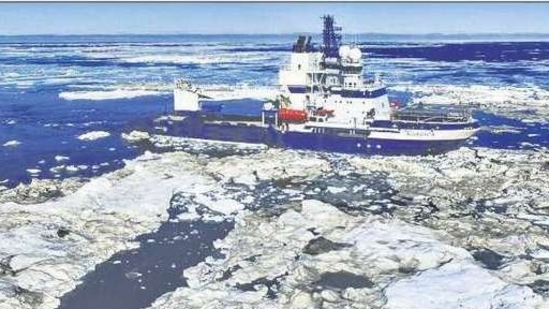Long-term warming close to crossing 1.5°C Paris accord threshold: UN body
HT reported on March 14 that the world could cross the 1.5 degrees C long-term global warming threshold by September 2029 if current warming trend continues
New Delhi : Long-term global warming is currently estimated to be between 1.34 and 1.41 degrees Celsius compared to pre-industrial levels, the World Meteorological Organisation’s State of the Global Climate report has said.

The assessment is based on a range of methods, the report said while pointing that we are a fraction of a degree away from breaching the 1.5 degrees C goal or the lower limit of Paris Agreement. To be sure, 19 of the past 20 months have seen the mark being breached, but scientists insist on a longer-term trend.
HT reported on March 14 that the world could cross the 1.5 degrees C long-term global warming threshold by September 2029 if current warming trend continues according to the Copernicus Climate Change Service (C3S) , a timeline that is significantly sooner than the “early 2030s” projection that was widely agreed upon by scientists. Ambient temperatures have already reached 1.38°C above the pre-industrial levels, C3S reported.
On Tuesday, WMO also said there were clear signs of human-induced climate change reaching new heights in 2024, with some of the consequences being irreversible over hundreds if not thousands of years and underlined that massive economic and social upheavals from extreme weather are to be expected. Atmospheric concentration of carbon dioxide are at the highest levels in the last 800,000 years, it said.
WMO’s State of the Global Climate report confirmed that 2024 was likely the first calendar year to be more than 1.5 degrees C above the pre-industrial era, with a global mean near-surface temperature of 1.55 ± 0.13 °C above the 1850-1900 average or pre-industrial levels. This is the warmest year in the 175-year observational record. “Our planet is issuing more distress signals — but this report shows that limiting long-term global temperature rise to 1.5 degrees Celsius is still possible. Leaders must step up to make it happen — seizing the benefits of cheap, clean renewables for their people and economies — with new National climate plans due this year, ” said United Nations Secretary-General António Guterres in a statement.
“Data for 2024 show that our oceans continued to warm, and sea levels continued to rise. The frozen parts of Earth’s surface, known as the cryosphere, are melting at an alarming rate: glaciers continue to retreat, and Antarctic sea ice reached its second-lowest extent ever recorded. Meanwhile, extreme weather continues to have devastating consequences around the world,” said Celeste Saulo, WMO Secretary-General in the statement.
Tropical cyclones, floods, droughts, and other hazards in 2024 led to the highest number of new displacements recorded for the past 16 years, contributed to worsening food crises, and caused massive economic losses.
Among key indicators, WMO highlighted that carbon dioxide concentrations in 2023 (the last year for which consolidated global annual figures are available) were 420.0 ± 0.1 parts per million (ppm), 2.3 ppm more than 2022 and 151% of the pre-industrial level (in 1750).
In 2024, ocean heat content reached its highest level in the 65-year observational record. Each of the past eight years has set a new record. The rate of ocean warming over the past two decades, 2005-2024, is more than twice that in the period 1960-2005. There is a steady decrease of global average ocean surface pH leading to ocean acidification. The most intense regional decreases in pH are in the Indian Ocean, the Southern Ocean, the eastern equatorial Pacific Ocean, the northern tropical Pacific, and some regions in the Atlantic Ocean. Projections by WMO show that ocean acidification will continue to increase in the 21st century, at rates dependent on future emissions. Changes in deep-ocean pH are irreversible on centennial to millennial time scales.
Further, in 2024, global mean sea level was the highest since the start of the satellite record in 1993 and the rate of increase from 2015-2024 was double that from 1993–2002, increasing from 2.1 mm per year to 4.7 mm per year. The period between 2022 and 2024 represents the most negative three-year glacier mass balance on record. Seven of the ten most negative mass balance years since 1950 have occurred since 2016. Exceptionally negative mass balances in glaciers were experienced in Norway, Sweden, Svalbard, and the tropical Andes.
The 18 lowest Arctic sea-ice minimum extents in the satellite record all occurred in the past 18 years. The annual minimum and maximum of Antarctic sea-ice extent were each the 2nd lowest in the observed record from 1979.
Extreme weather events in 2024 led to the highest number of new annual displacements since 2008 globally. These destroyed homes, critical infrastructure, forests, farmland and biodiversity. The compounded effect of various shocks, such as intensifying conflict, drought and high domestic food prices drove worsening food crises in 18 countries globally by mid-2024.
During summer on 2024, areas particularly affected by heatwaves included east Asia, south-east Europe, the Mediterranean and West Asia, and the south-western United States. This followed record-breaking heat in many parts of the northern hemisphere tropics during the pre-monsoon period from late March to May, including south-east Asia, West Africa and the Sahel, and Central America, as well as northern India. Among the most significant events was the June heatwave in Saudi Arabia, when temperatures near Mecca reached 50°C during the Hajj pilgrimage. Many casualties were reported during the pilgrimage, the large majority of which were partially or wholly attributable to the extreme heat, the report said.
Experts pointed to the absence of an agreed mechanism to monitor the temperature rise in the context of the Paris Agreement goals.
“For example, how do we define warming, surface temperature or air temperature, which dataset to go by, there are number of questions around this. How quickly we breach the 1.5°C goal is difficult to answer. In 2023-2024 temperatures have been higher than expected compared to background warming. It is being studied if this is a result of reduction in aerosols from certain sectors,” a WMO expert said on Tuesday during a briefing on the report.








